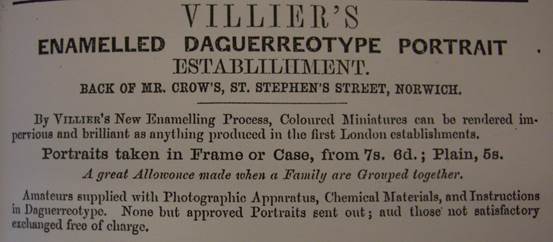1840 - 1860
Scene painter and enamelled Daguerreotypist
A George Villiers1 was married to an actress, Adelaide, and when working in Norwich, they lived with their two young sons in Norfolk Street, not far from the Theatre Royal in Norwich. James Zobel recorded in his diary2 that he and his wife paid a ‘thrupenny bit’ to visit Villiers’ Diorama where they saw ‘The Overland Mail to India.’ It seems possible, as there is only one Villiers in Norfolk listed in the 1851 Census, that he is our man. As an itinerant he is known to have visited Cromer, Holbeach, Leeds, Leicester, Worcester, Newport (Monmouthshire), Tenby, Torquay, Cardiff and Bristol.
He advertised Daguerreotype portraits in the Norfolk Chronicle, 31st July 1852.
Daguerreotype Portraits
For a Limited Time only,Great reduction in price, at
VILLIERS’ ESTABLISHMENT
AT ST. STEPHEN’S, NORWICH
Portraits taken from 5s, in morocco case
From 6s 6d, coloured 7s 6d, larger size
formerly £1 1s, now at 17s. Other sizes
reduced in proportion. Family groups from
10s 6d, on largest size plate from £2 2s.
Instruction given in the Art, also in
Archer’s Instantaneous Method of
Producing Pictures on Glass.
In 1852 an article appeared in the Norfolk Chronicle3, entitled
Photograph Portrait
‘The new process by which portraits can be taken on glass is now being adopted in this city. On Monday, we had an opportunity of seeing the process successfully carried out by Mr. Villiers, of St. Stephens, and portraits produced by it. Archer’s iodised collodion is spread over a piece of glass, which is then dipped into a chemical solution of nitrate of silver and – about 30 grains to one oz. of water. The glass, fixed in a slide, is then put into a camera, and a likeness is taken instantaneously. The time for the exposure of the camera to the light varies from 1 to 30 seconds. When the glass is taken out of the camera, a solution of pyrogallic and glacial acetic is poured over it, and the portrait is soon developed. The process is completed by putting the glass in hypo sulphite of acid, and leaving it to dry. This new mode of taking sun pictures is likely to be very useful to amateurs, architectural draughtsmen, and others. The materials required are much cheaper than for the Daguerreotype, and the process is easily acquired.’
The wet collodion process, a negative process, had been published by Frederick Scott Archer in 1851 in the March edition of The Chemist and in 1852 Villiers advertised the ‘Enamelled Daguerreotype Portrait’ in Mason’s Directory4.

He was offering portraits made by the collodion positive process, also known as the ambrotype5 (in north American usage), and by calling it the Enamelled Daguerreotype he revealed his business talent. Although his prices were comparable with those of his competitors who offered genuine Daguerreotypes, he made greater profits as his material costs were somewhat less.
He operated in St. Stephen’s Street in 1852 and St. Benedicts Gate6 in 1853.
No authenticated photographic image by Villiers has been seen by the author.
Sources and Notes
- British Census, 1851. George Villiers is listed, but no Villier.
- Edwards, J. K. [Ed.] The Diary of James George Zobel, Glass Stainer, Lady
Lane, Norwich. December 1827 – November 1858. Transcript, February,
1964. Original Mss. in the Norfolk Record Office. - Norwich Chronicle, Sat. 14 August, 1852, p2 c6
- Mason & Co.. Directory & Handbook. Norwich, etc., etc.. London: Mason & Co., 1852.
- 1854 English Patent by James Ambrose Cutting of Boston.
[Gr. ambrotos : immortal] - Heathcote, Bernard & Pauline. A Faithful Likeness - The First Photographic Portrait Studios in the British Isles, 1841 to 1855. Published by the authors: Lowdham, 2002.